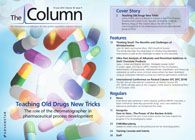International Conference on Packed Column SFC (SFC 2014)
The 8th Annual International Conference on Packed Column SFC (SFC 2014) will take place at the Congress Center Basel in Switzerland from 8–10 October 2014.
The 8th Annual International Conference on Packed Column SFC (SFC 2014) will take place at the Congress Center Basel in Switzerland from 8–10 October 2014.
SFC 2014 is a leading event in the supercritical fluid chromatography (SFC) calendar, alternating annually between the United States and Europe. The conference has previously been held in Philadelphia, USA; Pittsburgh, USA; New York City, USA; Stockholm, Sweden; Zurich, Switzerland; and Brussels, Belgium.

PHOTO CREDIT: RICHARD FAIRLESS/GETTY IMAGES
SFC can be a greener separation technology than high performance liquid chromatography (HPLC) because it uses carbon dioxide as the main mobile phase component. Over the past 15 years SFC has become the method of choice for preparative chiral and achiral separations up to 1 kg in scale. In addition, SFC provides a platform that offers faster separations with lower column pressure drops and thermal gradients. With appropriately packed column stationary phases and mobile phase components, separation mechanisms can be normal-phase, reversed-phase, ion pair, and hydrophilic interaction liquid chromatography (HILIC). Recent advances in analytical equipment have allowed SFC to move into validated analytical environments and have expanded its use. With the growth of SFC as a cutting-edge technology, this conference provides a forum for new developments and applications. SFC 2014 promises to attract distinguished scientists and academics from all around the world to discuss advancements in this environmentally friendly technology.
Day One: The conference begins with a half-day short course on 8 October. The course instructors — Larry Taylor from Virginia Tech (Virginia, USA) and Larry Miller from Amgen (Massachusetts, USA) — have a combined experience of over 40 years in SFC. Topics to be covered in the short course include: Fundamentals of analytical SFC; chiral chromatography with supercritical fluids; method development in achiral packed column SFC; and preparative SFC. The course is aimed at scientists with limited SFC experience, as well as those who are more experienced in the field. Past short courses have proven to be valuable as an introduction to SFC for experienced separation scientists looking to expand their knowledge base beyond HPLC.
Days Two and Three: Days two and three (9–10 October) will feature both oral and poster presentations from industrial and academic scientific leaders from around the world. Invited speakers include: Takeshi Bamba (Osaka University, Japan); Frédéric Begnaud (Firmenich SA, Switzerland); Stefan Buhler (Boehringer Ingelheim, Germany); David Guillarme (University of Geneva, Switzerland); Eric Lesellier and Caroline West (Universite d'Orleans, France). All topics related to SFC will be covered during the conference. Topics to be presented include: Analytical analysis, preparative purification, chiral and achiral method development, new detection technologies, and supercritical fluid extraction. Contributed abstracts are requested for both oral and poster presentations. The deadline for abstract submission for oral presentations is 15 July, for poster presentations the deadline is 15 August. Information on abstract submission can be found at www.greenchemistrygroup.org/Abstracts.html
In addition to scientific content, SFC 2014 includes vendor exhibits and vendor workshops where attendees can learn about the latest advances in SFC equipment and stationary phases from leading manufacturers.
E-mail: register@greenchemistrygroup.org
Website: http://greenchemistrygroup.org/
This article is from The Column. The full issue can be found here:http://images2.advanstar.com/PixelMags/lctc/digitaledition/June19-2014-uk.html#1

Investigating 3D-Printable Stationary Phases in Liquid Chromatography
May 7th 20253D printing technology has potential in chromatography, but a major challenge is developing materials with both high porosity and robust mechanical properties. Recently, scientists compared the separation performances of eight different 3D printable stationary phases.
Detecting Hyper-Fast Chromatographic Peaks Using Ion Mobility Spectrometry
May 6th 2025Ion mobility spectrometers can detect trace compounds quickly, though they can face various issues with detecting certain peaks. University of Hannover scientists created a new system for resolving hyper-fast gas chromatography (GC) peaks.
University of Oklahoma and UC Davis Researchers Probe Lipidomic Profiles with RP-LC–HRMS/MS
May 6th 2025A joint study between the University of Oklahoma Health Sciences Center (Oklahoma City, Oklahoma) and the UC Davis West Coast Metabolomics Center (Davis, California) identified differentially regulated lipids in type 2 diabetes (T2D) and obesity through the application of reversed-phase liquid chromatography-accurate mass tandem mass spectrometry (RP-LC-accurate MS/MS).

.png&w=3840&q=75)

.png&w=3840&q=75)



.png&w=3840&q=75)



.png&w=3840&q=75)










